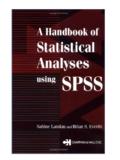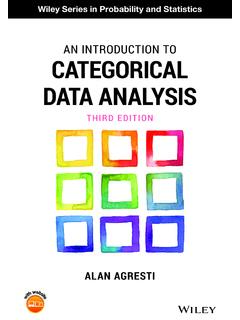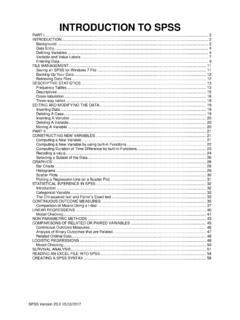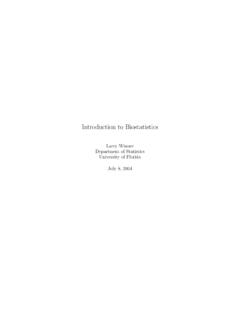Transcription of Core Guide: Longitudinal Data Analysis - Duke University
1 Core Guide: Longitudinal data Analysis 1 | P a g e Core Guide: Longitudinal data Analysis Part of a series addressing common issues in statistical and epidemiological design and Analysis Background In contrast to cross-sectional data , which are collected at a single time point, Longitudinal data are collected at multiple time points on the same individuals over time. These so called repeated measures data may be related to an exposure, or an outcome/event, or both. The primary benefit of collecting Longitudinal data is the ability to prospectively record the health outcome, as well as to measure an exposure that may be associated with this outcome.
2 Longitudinal studies are generally considered superior to cross-sectional studies in validly estimating risk; and prospectively measuring an exposure will reduce the possibility of misclassification of this exposure that frequently occurs in retrospective studies. Furthermore, Longitudinal data allow for measurement of changes in outcomes over time within a single unit of Analysis ( , an individual), and can tease apart different types of time-dependent effects; namely Age, Period and Cohort effects. Longitudinal cohort data usually include a short time series of repeated measured on the same unit of Analysis ( individuals).
3 This usually consists of many units of Analysis with a few repeated observations within units. Analysis of Longitudinal cohort data are the focus of this guide. Repeated cross-sectional data consist of repeated measures on different individuals, or other unit of Analysis , over time. Since repeated measures are on different individuals, we do not expect correlation among these measures due to individual characteristics; but we may observe correlation due to external factors, such as environmental or other seasonal effects. Time series data usually consist of a longer time series on a single (or small number of) individuals, or other unit of Analysis .
4 With time series Analysis , we assume temporal correlation in the response, but assume that if observations are far enough apart, they are essentially independent. In analyzing time series data , we are often focused on making inference to temporal dynamics within a population, such as the pattern and intensity of dengue fever, and less interested in inference to individual level risk factors for disease. Box A. Differences Between Three Common Structures of Longitudinal data Core Guide: Longitudinal data Analysis 2 | P a g e This guide will review the most common Longitudinal study designs, as well as the most appropriate methods for analyzing the resulting data .
5 Since Longitudinal data consist of repeated, and thus, correlated, measures on the same individual, or other unit, such as a village, appropriate analyses must be considered when analyzing data that exhibit this correlation structure. This guide will summarize analytic techniques for handling response correlation and will provide example Stata and SAS Analysis code. For a more detailed, technical discussion of modeling the correlation structure of Longitudinal data , see the DGHI Core Guide titled, Correlation Structures in Longitudinal data Analysis . Worked Example For the remainder of this guide, we will consider a Longitudinal study of HIV-positive pregnant women in rural Uganda.
6 The investigators want to determine whether exposure to a new intervention reduces HIV viral load among study participants. To this end, the investigators collect data on the outcome Y ( , viral load), exposure A ( , exposed to the intervention), as well as any other variables of interest, such as time period, T, or other covariates, L. Furthermore, the outcome is measured for all study participants at baseline and at least one follow-up time point ( it is a Longitudinal cohort study). This guide will consider several Longitudinal study designs that may be used to answer this research question.
7 We will review each of the primary designs questions listed in the table below, and discuss their implications for our resulting analyses. No. Question (Yes/No) 1a Is there a control group in the study , participants who were not exposed to the intervention? 1b If yes, then was the exposure randomized across participants; , is the study experimental? 2 Were the same participants measured at each time point? 3 Is there more than one follow-up time point? Pre-test/Post-test no controls The pre-test/post-test ( pre-post ) design is one of simplest forms of Longitudinal studies (Figure 1).
8 The study often consists of a single baseline measurement, Yt=0, and is compared to a single follow-up measurement, Yt=1, usually occurring after an intervention. Using our worked example, we might wish to measure viral load among HIV-positive pregnant women in a rural health facility in Uganda, before and after an intervention is initiated aimed at reducing viral load. Core Guide: Longitudinal data Analysis 3 | P a g e Figure 1. Schematic depiction of a pre-post study design, no controls. Since there is no control group ( , participants who were unexposed to the intervention), the baseline measurement is our best estimate of the counterfactual; that is, what would be the value of viral load for our study participants at t=1, had they remained unexposed to the intervention.
9 In this design, we answer our above key questions in the following way: No. Question (Yes/No) 1a Is there a control group in the study , participants who were not exposed to the intervention? No 1b If yes, then was the exposure randomized across participants; , is the study experimental? n/a 2 Were the same participants measured at each time point? Yes 3 Is there more than one follow-up time point? No Statistical Analysis Our pre-post data could be analyzed by taking the difference in the baseline and follow-up measurements and analyzing the resulting data . For example, if our outcome is viral load ( a continuous variable, which we assume to follow a Normal distribution), we might test the null hypothesis that the mean change in viral load over time is equal to zero.
10 We would difference the two values for each study participant, and then run a one-sample T-test to determine whether the observed mean CD4 count is different from zero (See Appendix for Stata and SAS code for performing all statistical analyses described in this document). Doing so would eliminate any correlation in the response since the investigator would have already removed it by differencing the two values, this analytic method is an appropriate method to account for the positive correlation that is expected between two outcomes measured on the same individual. Alternatively, we could retain both the baseline and follow-up measurements and perform a paired T-test to determine whether, on average, the difference in the two values is significantly different from zero.







